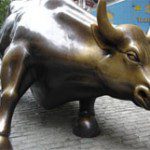During the longest bull market in modern history, the S&P 500 surged a whopping 418% over the 9.5 years between November 1990 and March 2000 but, in mere months, this famed bull market may lose its title as the “longest” in the modern era.
years between November 1990 and March 2000 but, in mere months, this famed bull market may lose its title as the “longest” in the modern era.
The original article has been edited here for length (…) and clarity ([ ]). For the latest – and most informative – financial articles sign up (in the top right corner) for your FREE tri-weekly Market Intelligence Report newsletter (see sample here)
According to data and analysis from LDL Research, the current bull market will take over the claim to fame in late August 2018. In today’s chart, we show every bull market since WWII, including the top six which are covered in more detail.
By looking at duration, total rate of return, and annualized rate of return, it really gives a sense of how these bull markets compare.
| Rank | Bull Market | Dates | Months | S&P 500 Return | Annualized Return |
|---|---|---|---|---|---|
| 1 | Great Expansion | ’90-’00 | 114 | 418% | 19.0% |
| 2 | Post-Crisis Bull Run | ’09-’18* | 112* | 302% | 16.7% |
| 3 | Post-War Boom | ’49-’56 | 86 | 267% | 20.0% |
| 4 | That ’70s Growth | ’74-’80 | 74 | 126% | 14.1% |
| 5 | Reagan Era | ’82-’87 | 60 | 229% | 26.7% |
| 6 | The Hot Aughts | ’02-’07 | 60 | 101% | 15.0% |
*Still in progress.
The current run, which will soon become the longest, didn’t have the same level of intensity as other high-ranking bull markets. Critics would say that it was artificially propped up by ultra-low rates, QE, and other government actions that will make the market ultimately less robust heading forward. Regardless, the current run ranks in fourth place among the markets above in terms of annualized return.
What Ended Each Bull?
The market psychology behind bull and bear markets can be fascinating. Below we look at the events credited with “ending” each bull market – though of course, it is actually the actions of investors (buying or selling) that ultimately dictates market direction.
1. The Great Expansion
The bull run lasted 9.5 years, ultimately capitulating when the Dotcom Bubble burst. From the span of June 1999 and May 2000, the Fed raised interest rates six times to try and get a “soft landing”. Market uncertainty was worsened by the 9/11 attacks that occurred the year after.
2. The Post-Crisis Bull Run
Still ongoing…
3. The Post-War Boom
This boom occurred after WWII, and it ended in 1956. Some of the sources we looked at credited the launch of Sputnik, Eisenhower’s heart attack, and the Hungarian Revolution as possible sources of market fear.
4. That ’70s Growth
The Iranian Revolution, the 1979 Energy Crisis, and the return of double-digit inflation were the factors blamed for the end of this bull.
5. Reagan Era
This bull market had the highest annualized return at 26.7%, but the party came to an end on Black Monday in 1987 – one of the most infamous market crashes ever. Some of the causes cited for the crash: program trading, overvaluation, illiquidity and market psychology.
6. The Hot Aughts
Stocks did decently well during the era of cheap credit and rising housing prices. However, the Financial Crisis put an end to this growth, and would cut the DJIA from 14,000 points to below 6,600 points.
 munKNEE.com Your Key to Making Money
munKNEE.com Your Key to Making Money
